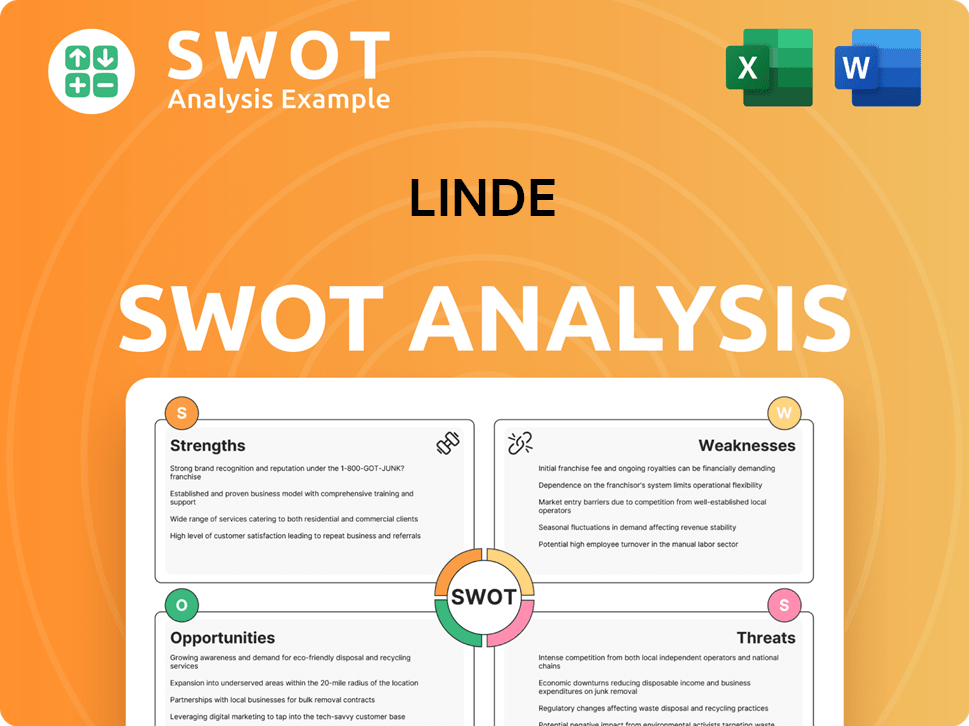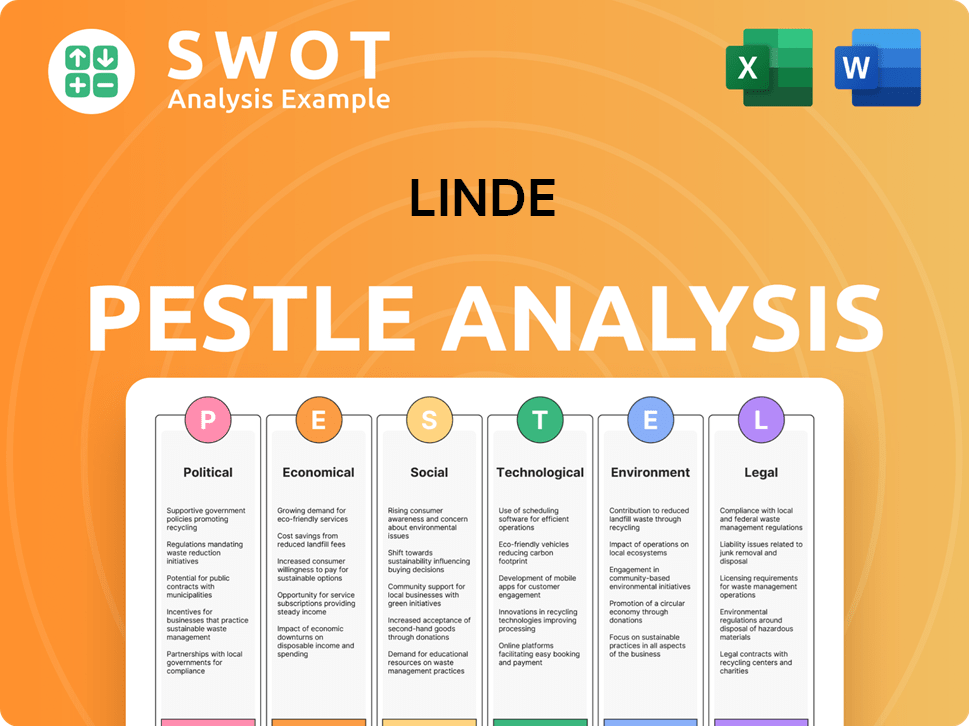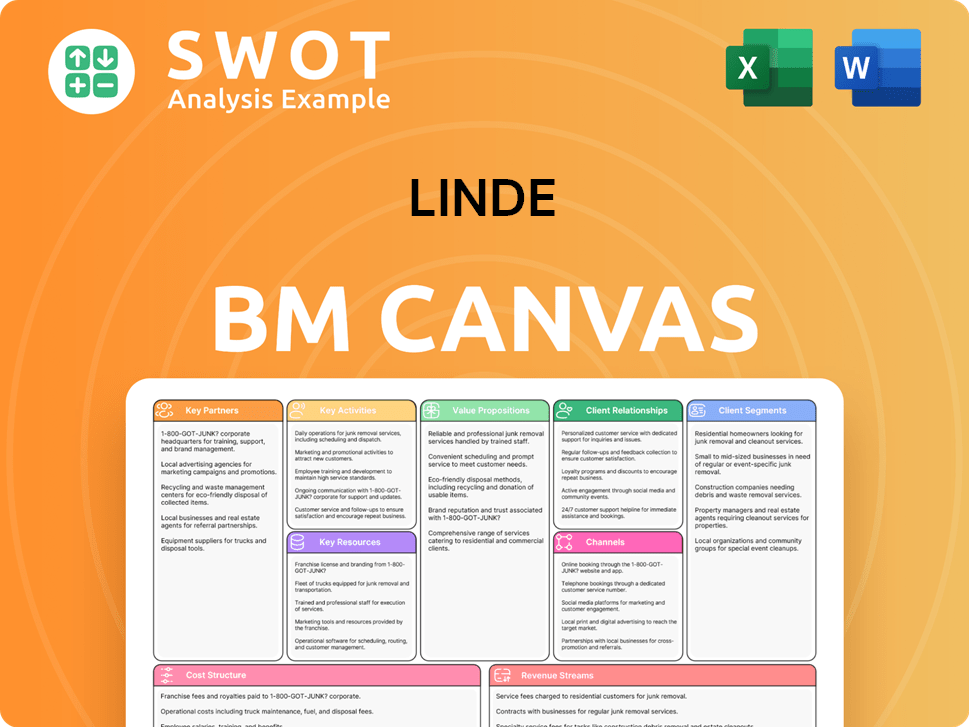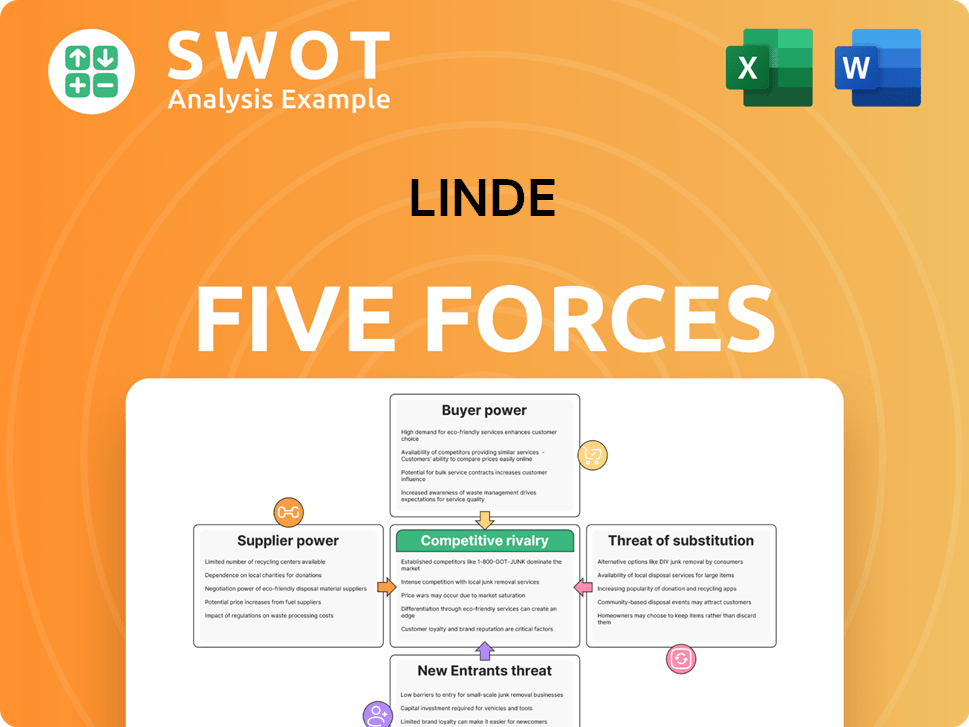Linde Bundle
How did a refrigeration machine revolutionize the world, and what company spearheaded this innovation?
Journey back to 1879 and discover the remarkable genesis of the Linde Company, a global leader in industrial gases. From its humble beginnings in Germany, this Linde SWOT Analysis reveals how Carl von Linde's invention of a refrigeration machine laid the groundwork for a century of groundbreaking achievements. Explore the pivotal moments that transformed a small engineering firm into a diversified powerhouse, impacting industries worldwide.

The brief history of Linde Company is a testament to innovation and strategic foresight. The Linde Group's evolution showcases its adaptability and resilience in the face of changing market dynamics. Understanding the Linde history, including its mergers and acquisitions, is crucial for grasping its current global presence and role in industrial gas production. This article will provide a comprehensive overview of Linde's key milestones and its impact on the industry.
What is the Linde Founding Story?
The Linde Company, a global leader in industrial gases and engineering, traces its origins back to a pivotal moment in industrial history. The Linde history began in 1879 with a visionary founder and a groundbreaking invention that would reshape several industries. This early start laid the foundation for what would become a multinational Linde Group.
Carl von Linde, a professor of mechanical engineering, established the company on June 21, 1879, in Wiesbaden, Germany. His expertise in thermodynamics and engineering was the driving force behind the company's initial innovation. The company’s focus was on developing efficient refrigeration technology, a critical need during the late 19th century's industrial boom.
The primary goal was to address the inefficiencies and safety concerns associated with existing cooling methods, particularly in breweries and food preservation. The first major product was an ammonia compression refrigeration machine, which quickly gained traction across European breweries. The company's name was derived from its founder's surname, reflecting the direct link between Carl von Linde's work and the company's core offerings. Initial funding likely came from Carl von Linde's resources and early investor interest, driven by the clear industrial demand for his invention. The rapid industrialization and scientific advancements of the late 19th century created a favorable environment for a company like Linde, which provided a crucial technological solution to emerging industrial needs.
The company's initial business model centered on the development and commercialization of refrigeration machines. This focus quickly expanded to include other industrial gases and related technologies.
- Refrigeration Machines: The first product was a highly efficient ammonia compression refrigeration machine.
- Early Adoption: The machines were quickly adopted by breweries across Europe, addressing a critical need for efficient cooling.
- Founder's Influence: The company's name reflected the direct link between Carl von Linde's pioneering work and its core offerings.
- Funding: Initial funding came from Carl von Linde's resources and early investor interest.
The company's early success was rooted in its ability to solve practical industrial problems. This approach set the stage for future innovations and expansions. For more insights into the company’s operations, consider reading about the Revenue Streams & Business Model of Linde.
Linde SWOT Analysis
- Complete SWOT Breakdown
- Fully Customizable
- Editable in Excel & Word
- Professional Formatting
- Investor-Ready Format

What Drove the Early Growth of Linde?
The early growth of the Linde Company was significantly driven by its advancements in refrigeration technology. Initially gaining traction in breweries, the company quickly expanded its reach to slaughterhouses and cold storage facilities, demonstrating the versatility of its innovations. Early product offerings included various refrigeration system models, which continually improved in both efficiency and capacity. As demand increased, the team grew, necessitating more engineers, technicians, and sales personnel. Early operations were centered in Germany, but the company soon began exploring international markets.
A pivotal moment in the
The competitive landscape, initially including other refrigeration companies, broadened to include emerging industrial gas producers. Linde's ability to innovate and diversify its product portfolio was key to its sustained growth. By the early 20th century, the company solidified its position as a technological leader in both refrigeration and industrial gases. The company's early success set the stage for future
Early expansion focused on establishing a global presence. By the early 1900s, the company began to set up operations in various countries. This expansion was crucial for capturing market share and establishing itself as a key player in the industrial gases and refrigeration industries. The international expansion also allowed it to capitalize on growing global demand for its products and services.
Technological advancements were central to the company's growth. Continuous improvements in air separation technology and refrigeration systems provided a competitive edge. These innovations not only enhanced product efficiency but also expanded the applications of industrial gases. The focus on research and development ensured that the company remained at the forefront of its industry, driving further growth and market penetration.
Linde PESTLE Analysis
- Covers All 6 PESTLE Categories
- No Research Needed – Save Hours of Work
- Built by Experts, Trusted by Consultants
- Instant Download, Ready to Use
- 100% Editable, Fully Customizable

What are the key Milestones in Linde history?
The Linde Company, a prominent player in the industrial gases sector, has a rich Linde history marked by significant milestones. The Linde Group's journey is characterized by pioneering achievements and strategic adaptations to navigate a dynamic global market. This journey has been shaped by technological advancements, strategic mergers and acquisitions, and responses to global economic shifts.
| Year | Milestone |
|---|---|
| 1879 | Carl von Linde founded the company, initially focusing on refrigeration technology. |
| 1902 | Linde successfully commercialized air liquefaction, enabling large-scale production of oxygen and nitrogen. |
| Early 20th Century | The company expanded its operations globally, establishing a strong presence in Europe and beyond. |
| 1960s-1980s | Linde diversified its product portfolio, entering the chemical company and engineering sectors. |
| 2018 | Linde merged with Praxair, forming Linde plc, creating a global leader in the industrial gases industry. |
Linde's innovations have continuously reshaped the industrial gases landscape. The company's early advancements in air separation technology laid the foundation for its future success. These innovations have led to a wide range of applications across various industries, solidifying its position as a leader in the field.
Linde's pioneering work in air liquefaction allowed for the efficient separation and production of oxygen and nitrogen. This technology revolutionized industries reliant on these gases, such as steelmaking and welding.
The company developed advanced cryogenic technologies for storing and transporting liquefied gases. These innovations were crucial for expanding the use of industrial gases across various sectors.
Linde developed high-purity gases for the electronics industry, essential for manufacturing semiconductors and other electronic components. These specialized gases ensured the quality and efficiency of production processes.
The company expanded its offerings to include medical gases, such as oxygen, for healthcare applications. These gases are critical for patient care and various medical treatments.
Linde has been involved in the production and distribution of hydrogen, a key component in various industrial processes and a growing focus in the energy sector. They are investing in hydrogen production and infrastructure.
Linde is also involved in carbon capture and storage technologies, aimed at reducing carbon emissions from industrial processes. This reflects their commitment to sustainability.
The Linde Company has faced numerous challenges throughout its history. These challenges have included economic downturns, competitive pressures, and the complexities of mergers and acquisitions. The company has consistently adapted and innovated to overcome these obstacles.
The two World Wars significantly impacted Linde's operations, requiring adaptation to wartime economies and subsequent reconstruction efforts. These periods demanded flexibility and strategic adjustments.
Economic recessions, such as the 2008-2009 global financial crisis, presented challenges by reducing industrial demand. Linde responded by optimizing its cost structure and focusing on resilient market segments.
Intense competition from other industrial gas giants has necessitated continuous innovation and efficiency improvements. Linde has consistently sought to maintain its market leadership through strategic initiatives.
The 2018 merger with Praxair, forming Linde plc, presented complex integration challenges related to corporate culture and operational harmonization. This strategic move, while beneficial, required careful management.
Navigating regulatory approvals across multiple jurisdictions during the merger with Praxair was another significant challenge. Compliance and legal processes demanded careful planning and execution.
Fluctuations in global markets, including changes in demand and supply, have presented challenges to the company's operations. Linde has responded by diversifying its product offerings and expanding its global presence.
For a deeper understanding of how Linde approaches its market strategies, consider exploring the Marketing Strategy of Linde.
Linde Business Model Canvas
- Complete 9-Block Business Model Canvas
- Effortlessly Communicate Your Business Strategy
- Investor-Ready BMC Format
- 100% Editable and Customizable
- Clear and Structured Layout

What is the Timeline of Key Events for Linde?
The Linde Company, a leading industrial gas and engineering company, has a rich history marked by innovation and strategic growth. Founded by Carl von Linde in 1879, the company initially focused on refrigeration technology before expanding into industrial gases. Over the years, through strategic acquisitions and technological advancements, Linde has grown into a global leader, significantly impacting various industries.
| Year | Key Event |
|---|---|
| 1879 | Carl von Linde founded Linde AG, initially focusing on refrigeration technology, marking the beginning of the Linde history. |
| 1895 | Carl von Linde successfully liquefied air in industrial quantities, a pivotal moment in the company's early years. |
| 1902 | The first large-scale air separation plant began operation, enabling the production of oxygen and nitrogen, revolutionizing industrial processes. |
| 1929 | Linde developed processes for producing rare gases like neon, argon, and krypton, expanding its portfolio of industrial gases. |
| 1960s | Expansion into the healthcare sector with medical gases, diversifying its applications. |
| 1970s | Significant international expansion and diversification of industrial gas applications, increasing its global presence. |
| 1990s | Focus on engineering and plant construction alongside gas production, enhancing its technological capabilities. |
| 2006 | Acquisition of BOC, significantly expanding its global reach and market share, a major Linde acquisition. |
| 2018 | Merger with Praxair to form Linde plc, creating the world's largest industrial gas company, a key milestone. |
| 2020-2024 | Continued focus on sustainability, hydrogen technologies, and digital transformation, shaping its future direction. |
Linde is heavily investing in hydrogen technologies, recognizing hydrogen's crucial role in decarbonizing industries and transportation. In 2024, Linde announced several new projects and partnerships aimed at advancing green hydrogen production and infrastructure. This strategic focus aligns with global efforts to reduce carbon emissions and is a key element of the company's growth strategy.
The company's focus on sustainable solutions, including carbon capture and utilization technologies, is expected to drive future growth. Linde's commitment to environmental stewardship is evident in its investments in sustainable technologies and its efforts to reduce its carbon footprint. This emphasis on sustainability is attracting investors and customers alike.
Analysts predict continued strong performance for Linde, driven by increasing demand for industrial gases in emerging markets and the ongoing global shift towards cleaner energy. The company's strategic positioning in key growth areas, such as hydrogen and carbon capture, supports a positive financial outlook. Linde's financial performance is expected to be robust.
Linde's future outlook remains firmly rooted in its founding vision of applying scientific innovation to solve critical industrial challenges, now with an added emphasis on environmental stewardship and sustainable development. This strategic focus will enable Linde to capitalize on global megatrends, particularly the energy transition and digitalization, securing its position as a leader in the chemical company industry.
Linde Porter's Five Forces Analysis
- Covers All 5 Competitive Forces in Detail
- Structured for Consultants, Students, and Founders
- 100% Editable in Microsoft Word & Excel
- Instant Digital Download – Use Immediately
- Compatible with Mac & PC – Fully Unlocked

Related Blogs
- What is Competitive Landscape of Linde Company?
- What is Growth Strategy and Future Prospects of Linde Company?
- How Does Linde Company Work?
- What is Sales and Marketing Strategy of Linde Company?
- What is Brief History of Linde Company?
- Who Owns Linde Company?
- What is Customer Demographics and Target Market of Linde Company?
Disclaimer
All information, articles, and product details provided on this website are for general informational and educational purposes only. We do not claim any ownership over, nor do we intend to infringe upon, any trademarks, copyrights, logos, brand names, or other intellectual property mentioned or depicted on this site. Such intellectual property remains the property of its respective owners, and any references here are made solely for identification or informational purposes, without implying any affiliation, endorsement, or partnership.
We make no representations or warranties, express or implied, regarding the accuracy, completeness, or suitability of any content or products presented. Nothing on this website should be construed as legal, tax, investment, financial, medical, or other professional advice. In addition, no part of this site—including articles or product references—constitutes a solicitation, recommendation, endorsement, advertisement, or offer to buy or sell any securities, franchises, or other financial instruments, particularly in jurisdictions where such activity would be unlawful.
All content is of a general nature and may not address the specific circumstances of any individual or entity. It is not a substitute for professional advice or services. Any actions you take based on the information provided here are strictly at your own risk. You accept full responsibility for any decisions or outcomes arising from your use of this website and agree to release us from any liability in connection with your use of, or reliance upon, the content or products found herein.